The DJI Spark is the smallest, cheapest obstacle-avoiding drone yet
If I’ve learned one thing from reviewing drones, it’s this: You, dear reader, either love ‘em or hate ‘em.
Some people are horrified that drone sales more than doubled last year, that they’re expected to increase 10X in the next five years, that the skies will soon fill up with noisy, dangerous spying machines.
Other people are exhilarated by the prospect of breaking free from our flat, two-dimensional existence. They love that they can come breathtakingly close to having jetpacks, going where they want, looking where they want. No wonder drones are revolutionizing filmmaking, engineering, farming, law enforcement, search and rescue, real estate, and on and on.
Both kinds of readers should be interested in this month’s drone news, then: The arrival of the smallest, least expensive smart drone ever made.
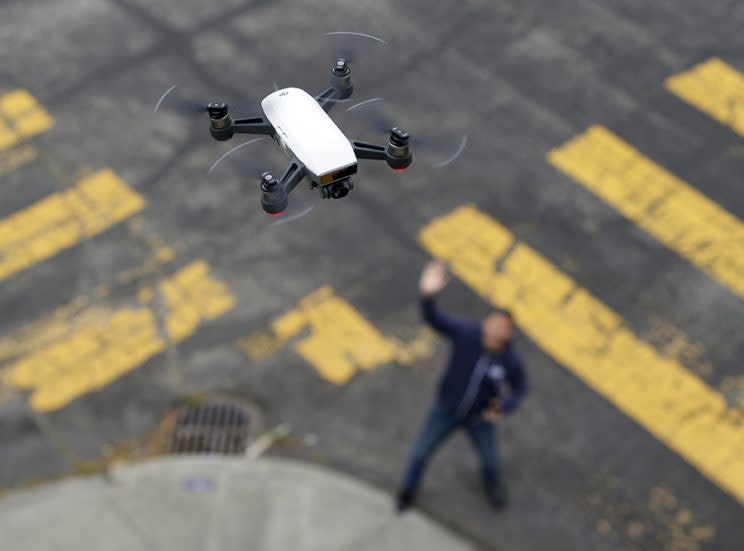
It’s the DJI Spark. At $500, it’s not the impulse buy for the masses that DJI seems to think it is (“great for spontaneous selfies!”). But it does bring smart, high-quality drones within reach of many more people. Which means more student filmmakers doing professional work, more real-estate offices shooting fly-throughs of homes, more gorgeously produced marching-band videos.
And more drones in the sky. Sorry about that, drone haters.
The size
The price of the Spark is a big deal—but the size of the Spark is an even bigger (smaller?) deal. It’s tiny.
Videos and photos don’t even capture it. The body of this thing is the size of your phone, or a soda can.
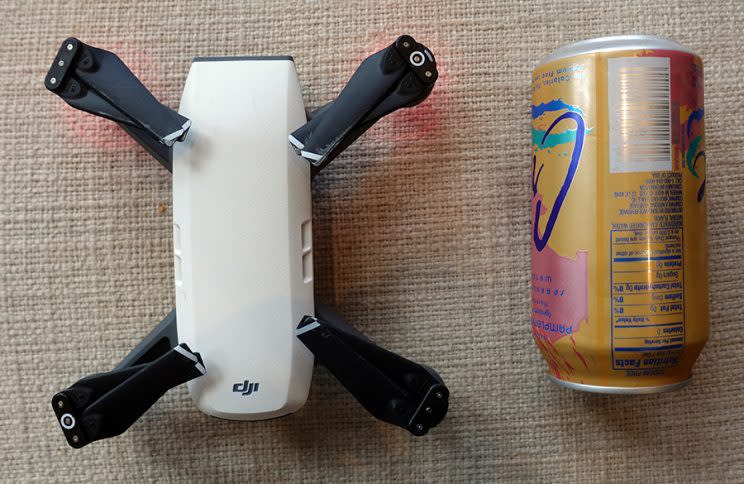
The Spark’s shape resembles its big brother, the $1,000 Mavic Pro, which DJI released only eight months ago (here’s my review), and offers many of the same advantages. But the Spark is a mini-me Mavic, only 5.5 inches square, including the propellers; the Mavic is twice as big. (Then again, the Mavic’s struts and propellers fold down against the body, and the Spark’s don’t.)
Small is huge. Small means you can carry your drone with you more often, to more places. Small means you can capture video from inside smaller spaces. Small means less intimidating to whoever you’re filming, and less suspicious to authority figures. (Of course, you should always fly only where it’s legal. Here are the rules.)
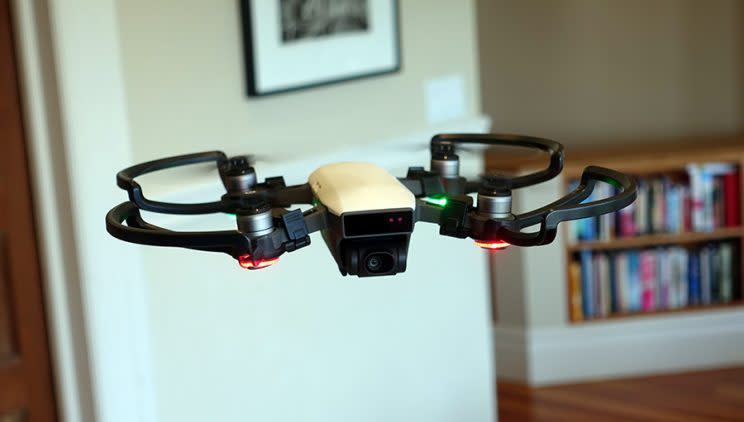
How to fly
You can control the Spark in any of three ways.
First, you can use the optional remote control ($150, not available yet). (The remote also comes in the $700 “Fly More” kit, which includes the Spark, the remote, two batteries, four spare propellers, propeller guards for indoor flight, a fantastic three-battery charger, a shoulder bag, and all necessary cables. The $500 basic kit includes only the drone, two spare propellers, and one battery. You charge the drone by connecting it to a micro-USB cable, much as you would a phone.)
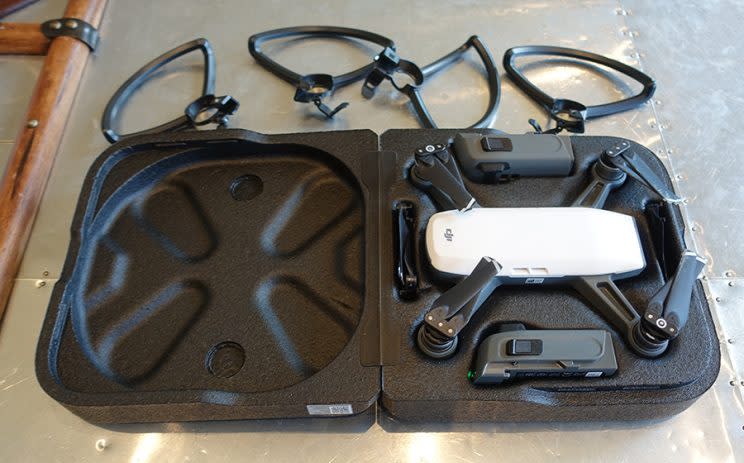
The remote doesn’t just give you flight joysticks; it also grants you Sport mode, which unlocks the Spark’s top speed of 31 mph, and a 4.3-mile range. Of course, you should take that figure, and all range and battery-life claims, with a grain of salt the size of Texas; you’ll never get that kind of range in the real world.
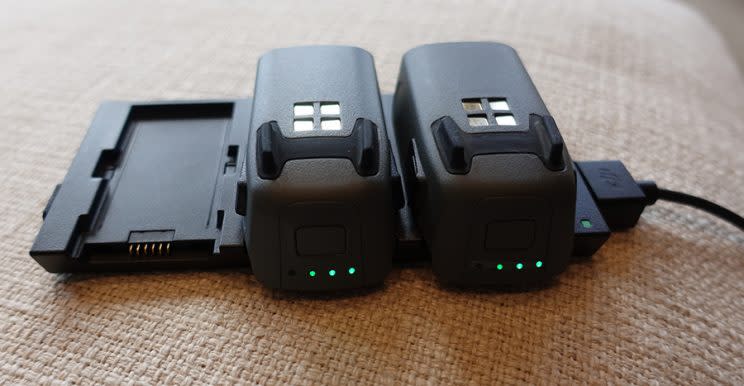
The second way to fly the drone is using your smartphone. It works great—the screen shows you what the drone’s camera is seeing—and you can tilt the camera up or down by tipping the phone up and down.
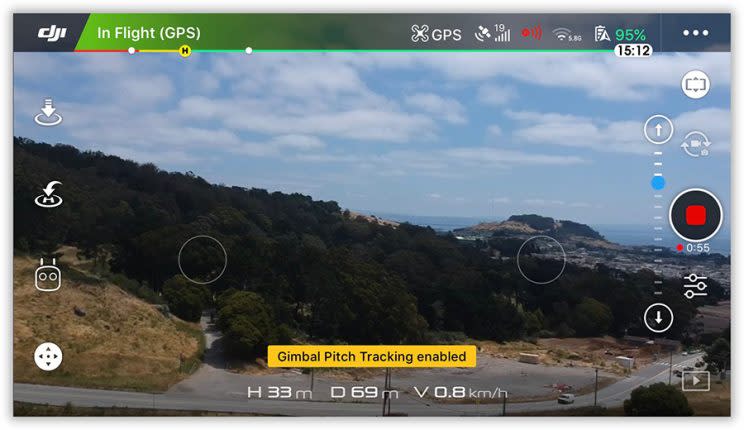
The range with the phone, though, isn’t great. DJI says 50 yards up and 100 yards away. But in my testing, the drone lost signal with the phone sooner than that. Fortunately, whenever that happens, the Spark is religious about kicking into Return Home mode. Wait a couple of minutes, and it will calmly descend to the precise spot where it took off.
Using the Force
There’s a third way to control the Spark, though, and this may be the biggest headline of all: You can control it with hand gestures.
You can start holding the Spark on your hand at arm’s length, and double-press its power button. After about 15 seconds, the drone’s front-facing depth sensor recognizes your face, takes off from your hand, and hovers.
At this point, you can hold your palm out toward the drone and “drag” it up, down, or around you in any direction; the drone follows as though connected to your palm by a magnet. It’s the closest thing to The Force you’ll ever get to try.
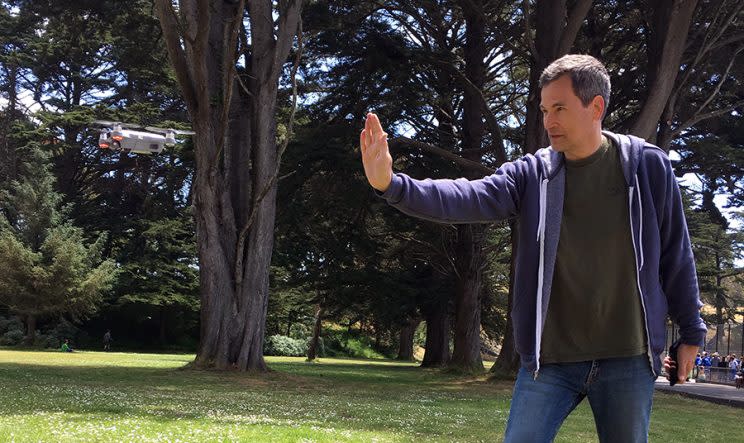
Wave “goodbye,” and the Spark flies 10 feet up and 10 feet away and hovers; hold out your fingers like a director framing a shot, and the drone counts down and takes a photo of you; make a Y with your arms, and the drone flies back to you. Hold out your palm underneath, and the drone gently and reliably lowers itself into your hand and cuts power to the props.
This hand-control business is so cool and fun that people tend to forget its original purpose: To give you a simple way of positioning the drone in space for group photos and selfies.
That’s why, somewhat disappointingly, you can use The Force only when the drone is about three feet away from you. Any farther, and it doesn’t respond.
You can also use The Force only after fiddling with some settings in the phone app. (In other words, you still have to own a smartphone to use the Spark.) And even then, I sometimes had trouble getting it to work.
Why the Spark?
The Spark offers all the same intelligence as the Mavic Pro. For example, its Obstacle Avoidance feature prevents it from crashing into something ahead of it; it jerks to a halt about eight feet away and hovers. (It can, however, crash when flying in any other direction.) And its underbelly camera takes an internal video of the launch spot, so that when you tell the drone to Return Home, it lands in that exact spot.
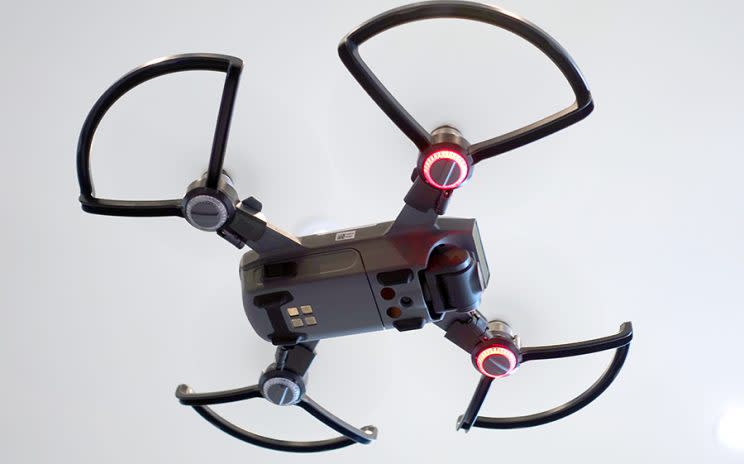
Both drones are built like tanks. They feel solid, and they survive a lot of crashes.
Yet the Spark is about half the size of the Mavic, and costs one-third less. The Spark is also available in a choice of colors (white, green, yellow, blue, red), which the Mavic (gray) is not.
Both drones can fly themselves in preprogrammed flight paths while recording video. They both offer Orbit (flies around you, camera pointed at you), Active Track (the drone follows you as you run, drive, ski, unicycle, whatever), and Tap Fly (on the phone app’s screen, you draw a path with your finger for the drone to follow).
But the Spark also includes four QuickShots—preprogrammed flight stunts that capture 10-second videos for quick sharing from your phone. There’s Circle (one orbit around you), Helix (rising in bigger and bigger circles), Rocket (straight up, filming straight down), and Dronie (flies up and away).
The Spark also offers two new still-photo modes: Portrait, which creates a simulated blurry-background effect, and the very cool Panorama, in which the drone hovers in the air, taking a photo, turning a few degrees, taking another, and so on, and then stitching the shots into one super-wide result.

Given all of these advantages, why on earth would anyone still buy the Mavic?
Well, because there are two key limitations to the Spark.
Flight time. Each Spark battery lasts for “16 minutes” of flight, which is about 12 minutes in the real world. The Mavic’s battery lasts for “27 minutes,” which means about 20.
Video quality. The Spark’s 1080p hi-def video (and 12 megapixel stills) look great. The two-axis camera gimbal keeps the video rock solid, even in buffeting winds (yes, I tried it.) Still, the Mavic captures 4K video—four times as many pixels—if you care about such things.
Here are a few minutes of video taken by the Spark:
The drone of things to come
The DJI Spark really is an astonishing piece of technology. It carves out a new spot on the spectrum of drone size/price/performance.
Of course, it still doesn’t fit in your jeans pocket, still doesn’t fly for an hour on a charge, still isn’t crash-proof.
But clearly, those are the three goals DJI has set for itself. At this rate, the drones DJI comes up with this time next year will be more like mosquitoes than machines. Depending on how you feel about drones, that’s fantastic news—or terrible news.
More from David Pogue:
Inside the World’s Greatest Scavenger Hunt: Part 1 • Part 2 • Part 3 • Part 4 • Part 5
The new Samsung Galaxy does 27 things the iPhone doesn’t
The most important announcements from Google’s big developer’s conference
Google Home’s mastermind has no intention of losing to Amazon
Google exec explains how Google Assistant just got smarter
Amazon’s Alexa calling is like a Jetsons version of the home phone
David Pogue, tech columnist for Yahoo Finance, welcomes nontoxic comments in the comments section below. On the web, he’s davidpogue.com. On Twitter, he’s @pogue. On email, he’s poguester@yahoo.com. You can read all his articles here, or you can sign up to get his columns by email.

 Yahoo Finance
Yahoo Finance 
